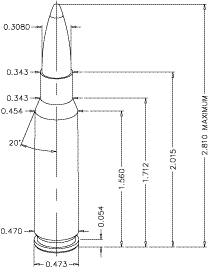| 308 Winchester | |
 |
Test Specifications Firearm Used: Savage 12VSS Bbl. Length/Twist: 26″/1×10″ Test Components |
|
Remarks:
Shortly after the end of World War I, the U.S. Ordnance Corps began looking for a smaller cartridge to replace the 30-06 Springfield. With typical government efficiency, the quest was still being pursued toward the end of the Second World War. By 1944, engineers at Frankford Arsenal had begun to experiment with the 300 Savage case. Designated as the Cartridge, Ball, Cal. 30 T65, the experimental round gave performance roughly equal to the larger 30-06. After a long series of modifications, a revised cartridge case designated as the T65E3 was adopted as the NATO standard on December 15, 1953. The U.S. finally embraced the 7.62mm NATO cartridge in two new weapons adopted in 1957 – the M14 rifle and the M60 machinegun.While the military trials were still in progress, Winchester introduced the cartridge to the sporting public as the 308 Winchester. Initially, the 308 was chambered in the bolt action Model 70 rifle. Since then, the cartridge has been chambered by virtually every major arms maker in almost every conceivable action type. Public acceptance was slow, due largely to unflattering comparisons to the 30-06. Despite the initial lukewarm enthusiasm, the 308 has become one of the most useful sporting cartridges. The 308 is an extremely easy cartridge to reload. Like the 222 Remington and 6mm PPC, the 308 is an extremely accurate cartridge. It probably is the most inherently accurate 30 caliber commercial cartridge ever produced. As a competitive cartridge, the 308 has been used in benchrest, highpower, long-range, silhouette, and 300-meter international matches. Few, if any, other cartridges have been so successful in such a wide range of shooting disciplines. It has also become quite popular as a hunting cartridge and is adequate for most North American big game species, particularly deer-sized game. Though frequently compared to it, the 308 cannot match the performance of the 30-06. The difference between the two, however, is insignificant unless bullets of 180 grains or heavier are discussed. The 30-06’s greater capacity and ability to use slower powders give it an undeniable edge. If military brass is used for reloading, the charges shown should be reduced by one to two grains. The thicker construction of these cases decreases capacity, making a reduction in charge weight a necessity. |
|
Featured
Sierra Bullets > Featured
